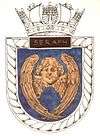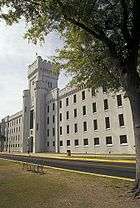HMS Seraph (P219)
 HMS Seraph | |
| History | |
|---|---|
| Name: | HMS Seraph |
| Ordered: | 23 June 1940 |
| Builder: | Vickers Armstrong Ltd - Barrow-in-Furness |
| Laid down: | 16 August 1940 |
| Launched: | 25 October 1941 |
| Commissioned: | 27 June 1942 |
| Decommissioned: | 25 October 1962 |
| Fate: | Scrapped |
| General characteristics | |
| Displacement: |
|
| Length: | 217 ft (66 m) |
| Beam: | 23 ft 6 in (7.16 m) |
| Draught: | 11 ft (3.4 m) |
| Propulsion: |
|
| Speed: |
|
| Complement: | 44 officers and men |
| Armament: |
|
| Notes: |
 |
HMS Seraph (pennant number P219) was an S-class submarine of the British Royal Navy. She carried out a number of intelligence and special operations activities during World War II, the most famous of which was Operation Mincemeat.
Seraph was one of the third batch of S-class submarines, built by Vickers Armstrong at Barrow-in-Furness. She was laid down on 16 August 1940, launched on 25 October 1941 and commissioned on 27 June 1942. After going through her working up trials she carried out a fourteen-day patrol off Norway in July. On her way to the Mediterranean she was attacked in error by an Armstrong Whitworth Whitley bomber of the Royal Air Force at Cape Finisterre, although she did not suffer any damage.
She was afterwards assigned to the 8th Submarine Flotilla in the Mediterranean on 25 August; she found herself selected to carry out special operations duties. Of the missions she carried out, three stand out among the rest.
Operation Flagpole
Seraph first saw action in support of Operation Torch, the Allied landings in North Africa; her first combat mission, under the command of Lieutenant Norman "Bill" Jewell, was carrying out a periscope reconnaissance of the Algerian coast during the last two weeks of September 1942.
Upon her return to Gibraltar, Seraph was assigned to Operation Flagpole, the carrying of General Dwight Eisenhower's deputy, Lieutenant General Mark W. Clark, to North Africa for secret negotiations with Vichy French officers. Loaded with collapsible canoes, submachine guns, walkie-talkies, and other supplies, the submarine carried Clark, two other United States Army generals, United States Navy Captain Jerauld Wright, several other officers, and three British Commandos.
Seraph then sailed to the Algerian coast on 19 October 1942. On the night of 20 October her passengers disembarked ashore. The operation was very important as it helped to reduce French opposition to the Torch landings (although the French were not informed that the troop ships were already on their way and the landings were due in just a few days).
General Clark and his party were then picked up on 25 October by the submarine after some inadvertent delays. After an uneventful return journey, Seraph landed her party in Gibraltar on 25 October.
Operation Kingpin: "the ship with two captains"
On 27 October, Jewell was ordered to set sail again to the coast of southern France for a secret rendezvous. Seraph was ordered to patrol up and down the coast until she received a signal giving her the name of the port from which she was to pick up her passengers. On the night of 5 November she finally arrived at a location some 20 miles (32 km) east of Toulon, as arranged to secretly take aboard French General Henri Giraud, his son, and three staff officers for a meeting with Eisenhower in Gibraltar, with the intention to enlist the support of the pro-Vichy forces at Oran and Casablanca to the Allied cause.
In picking up the general's party, a bit of legerdemain was needed: because Giraud flatly refused to deal with the British, and there was no US boat within 3,000 miles (4,800 km), HMS Seraph briefly became the "USS Seraph", flying the US Navy ensign. Nominally the sub came under the command of Captain Jerauld Wright, who was earlier involved in the Flagpole operation, although Jewell took care of actual operations. In the spirit of things the British crew affected American accents that they imitated from the movies. However, it fooled nobody — including Giraud, who had been told of the deception by Wright.
After the pick-up, on 7 November Seraph transferred her charges to a PBY Catalina flying boat that was sent from Gibraltar to search for her after they lost contact with the sub due to a problem with her main radio.
On 24 November, Seraph sailed on her first war patrol in the Mediterranean. She was soon called upon to join other submarines in carrying U.S. and British Commandos for reconnaissance operations in the area. On 2 December 1942 she torpedoed and damaged the Italian merchant ship Puccini. Later that month, on 23 December she rammed and damaged a U-boat, sustaining sufficient damage herself to necessitate repairs and refit back to Britain.
Operation Mincemeat
Seraph returned to Blyth, northern England, for a much needed overhaul and leave on 28 January 1943. A few weeks later, Jewell was briefed at the Admiralty on Operation Mincemeat, to be carried out during Seraph's return to the Mediterranean. This mission was part of Operation Barclay, a plan to convince the Germans that the Allies intended to land in Greece and Sardinia, and not Sicily.
She set sail again on 19 April, carrying a special passenger. This was a corpse in a metal canister, packed in dry ice, and dressed in a Royal Marines uniform. Attached to the corpse was a briefcase containing faked "secret documents" designed to mislead the Axis.
In the early hours of 30 April Seraph surfaced off the coast of Spain, near the port of Huelva. Jewell and his officers launched the body and briefcase in the water, disposing of the canister in deeper waters. Jewell then radioed the signal "MINCEMEAT completed" while the submarine continued to Gibraltar. The body was picked up by the Spanish, who decided it was a courier killed in an aircraft accident. The false documents were passed to the Germans and led them to divert forces from the defence of Sicily.
Other missions
By late April 1943 Seraph was back in the Mediterranean operating east of Sardinia and on 27 April she fired a salvo of three torpedoes at a merchant ship off the Strait of Bonifacio but was not successful. Again on the last two days of that month she made similar attacks but none of these was successful, and Seraph ended up being depth-charged each time. She was not damaged during these engagements, with no lives lost.
In July, during the Allied invasion of Sicily, she acted as a guide ship for the invasion force.
For the remainder of 1943 the Seraph operated against German and Italian forces in the Mediterranean theater and attacked several convoys, but her performance in that area was lacklustre, sinking only a few small ships.

In December, 1943, she sailed to Chatham for a much needed refit, after which she operated in the eastern Atlantic and Norwegian Sea, until she carried out her final patrol in the English Channel, serving as a guide ship to the Normandy landings on 6 June 1944, before her conversion as a training boat for anti-submarine warfare operations.
The Admiralty had received intelligence in early 1944 about new U-boats which were reported to be able to achieve a top speed of around 16 knots (30 km/h) underwater, compared to the 9 knots (17 km/h) of the fastest existing U-boats. As these new XXI-class U-boats were considered to pose a major threat, Seraph was modified at Devonport as a matter of urgency to have a high underwater speed so that trials and exercises could be carried out against a submarine having a similar underwater speed; for example in developing new tactics.
The submarine was streamlined by careful attention to the attachments on the outside of the hull, the size of the bridge reduced, the gun was removed along with one of the periscopes and the radar mast, and torpedo tubes blanked over. The motors were upgraded and higher capacity batteries fitted along with replacement of the propellors with the coarser pitched type used on the larger T class submarines.[1]
After the war
Seraph remained in active service after the war. In 1955 she was fitted with armour plating and used as a torpedo target boat. She was attached to a squadron commanded by none other than her first skipper, now Captain Jewell. Also during this time, the Seraph appeared as herself in the British Film The Man Who Never Was, which details her exploits during Operation Mincemeat. Her identifying marks are visible in a number of scenes during the movie.
She remained in commission until 25 October 1962, 21 years to the day after her launching.
When she arrived at Briton Ferry for scrapping on 20 December 1962, parts from her conning tower and a torpedo loading hatch were preserved as a memorial at The Citadel in Charleston, South Carolina, where General Clark served as president from 1954–1965. This monument is the only shore installation in the United States where the Royal Navy ensign is authorized to be permanently flown by the British Admiralty. It flies alongside the US flag to commemorate Anglo-American cooperation during World War II.[2][3][4]
References
- Notes
- ↑ Brown, DK, Nelson to Vanguard
- ↑ "British ambassador lays wreath at The Citadel". AP. April 16, 2013. Retrieved June 4, 2013.
- ↑ "Raising the Ensign". News and Courier. Charleston, SC. March 28, 1980. p. B1.
- ↑ http://www.royalnavy.mod.uk/News-and-Events/Reference-Library/~/media/Files/Navy-PDFs/News-and-Events/Naval%20Publications/BR%202/brd2book/ch91.pdf
- Bibliography
- Colledge, J. J.; Warlow, Ben (2006) [1969]. Ships of the Royal Navy: The Complete Record of all Fighting Ships of the Royal Navy (Rev. ed.). London: Chatham Publishing. ISBN 978-1-86176-281-8. OCLC 67375475.
See also: reference to HMS Seraph in 'FDR's 12 Apostles', The Spies who paved the way for the invasion of North Africa, Hal Vaughan,Lyons Press, 2006, 311 pp
External links
| Wikimedia Commons has media related to HMS Seraph (P219). |
- Seraph monument at The Citadel The Military College of South Carolina
- History of HMS SERAPH (P.219) uboat.net
- Allied Submarine Attacks Suche: SERAPH
